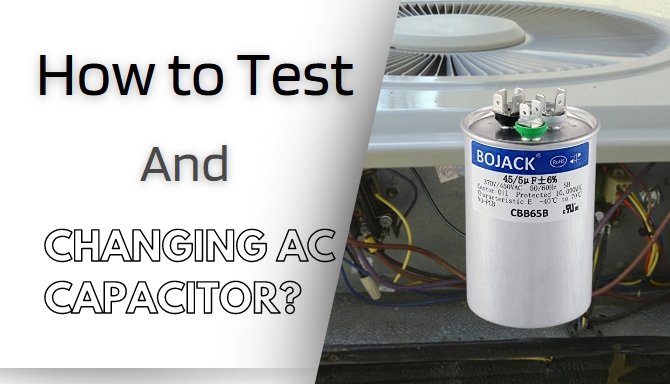As an expert in the HVAC industry with over 20 years of experience and multiple certifications, I have encountered numerous issues related to AC units. Among the most critical components is the capacitor. This small but essential part ensures the smooth operation of the motors, and its failure can lead to significant problems.
This article provides in-depth knowledge and insights on identifying, testing, and replacing a faulty and how to changing ac capacitor.

How Can I Tell if My AC Capacitor Is Bad?
Before considering a replacement, it is crucial to recognize the signs of a failing capacitor. Here are some common indicators:
- Your AC doesn’t blow cold air. If your AC produces warm air instead of cold, it may indicate a capacitor issue. This anomaly often suggests that the motors are not receiving enough power to function correctly.
- You hear a humming noise when it’s on. A humming noise can indicate that the capacitor is struggling to start the motor. This sound usually means the motor is trying to start without sufficient electrical support.
- Your energy bill is skyrocketing. A bad capacitor forces the AC unit to work harder, consuming more electricity and producing higher energy bills.
- Your AC doesn’t start right away. Normally, an AC should start immediately after being turned on. A delayed start can signal a failing capacitor that cannot provide the initial energy boost needed.
- Your AC tends to turn itself off frequently. If your AC unit shuts off on its own frequently, it could be due to an unstable capacitor that cannot maintain a steady energy flow.
- Your AC won’t turn on at all. This is the most severe sign. If the capacitor is completely dead, the AC unit won’t start, rendering the system non-functional.
Read also: Does Your Window Air Conditioner Turns On and Off Right Away?
How to Test AC Capacitor?
Testing an AC capacitor requires careful attention to safety and procedure. Here’s a step-by-step guide:
| Step | Description |
|---|---|
| 1. Cut the Power Off | Ensure your AC unit is completely powered down to avoid any risk of electric shock. |
| 2. Locate the Capacitor | Remove the unit’s access panel to find the capacitor, typically a cylindrical component connected to various colored wires. |
| 3. Discharge the Capacitor | Capacitors store electrical energy. Use an insulated screwdriver to discharge it by connecting the screwdriver across the terminals. |
| 4. Document Wiring Setup | Take a photo of the current wiring setup for reference. This will help ensure you reconnect the new capacitor correctly. |
| 5. Remove the Capacitor | Disconnect the wires, unscrew the brackets, and carefully remove the capacitor. |
| 6. Inspect the Capacitor | Check for signs of damage like bulging or leaking. |
| 7. Identify the Rating | Ensure the new capacitor matches the old one in terms of microfarads (µF) and voltage rating. |
| 8. Set Up the Multimeter | Prepare your multimeter for testing by setting it to the appropriate mode. |
| 9. Test the Capacitor | Measure the capacitance and compare it to the rating printed on the capacitor. Follow specific procedures for single or dual-type capacitors. |
Testing Procedure for Capacitors
- Single-Type Capacitor: Measure the capacitance and compare it to the rating printed on the capacitor.
- Dual-Type Capacitor: Measure the capacitance between the common terminal and each of the other terminals (e.g., HERM and FAN).
For more detailed guidance, refer to credible sources such as HVAC training manuals or consult professional technicians who can advise on capacitor testing.
Can I Replace the AC Capacitor Myself?
It’s highly inadvisable to changing ac capacitor yourself unless you are a certified technician. This job involves significant risks, including electric shock and improper installation, which can lead to severe consequences.
Professional Expertise and Safety
Hiring a professional ensures the job is done safely and correctly. Technicians are trained to handle electrical components, diagnose issues accurately, and install parts according to industry standards.
Step-by-Step Guide to Replacing an AC Capacitor
For those who are qualified and experienced, here is a detailed guide:
| Step | Description |
|---|---|
| 1. Power Off the Unit | Switch off the AC unit at the breaker box to ensure there is no power supply. |
| 2. Access the Capacitor | Remove the access panel of the AC unit. Typically, this is done by unscrewing a few bolts. |
| 3. Discharge the Capacitor | Use an insulated screwdriver to discharge any stored electrical charge from the capacitor by connecting the screwdriver across the terminals. |
| 4. Document Wiring Setup | Take a photo of the current wiring setup for reference. This will help ensure you reconnect the new capacitor correctly. |
| 5. Remove the Capacitor | Disconnect the wires from the old capacitor. Use a screwdriver to remove any screws holding the capacitor in place, and then carefully take it out. |
| 6. Inspect the New Capacitor | An insulated screwdriver discharges any stored electrical charge from the capacitor by connecting the screwdriver across the terminals. |
| 7. Install the New Capacitor | Place the new capacitor in the same position as the old one. Secure it with screws and reconnect the wires according to your reference photo. |
| 8. Reassemble the Unit | Replace the access panel and secure it with screws. |
| 9. Test the Unit | Switch the power back on at the breaker box and test the AC unit. Observe if it starts properly and runs smoothly. |
Common Mistakes to Avoid
Changing an AC capacitor can seem straightforward, but there are common mistakes to avoid:
- Not Cutting Power Completely: Ensure that the power is completely off to avoid electric shock.
- Incorrect Capacitor Rating: Always use a capacitor with the same microfarad and voltage rating as the original.
- Improper Discharge: Failing to discharge the capacitor can lead to dangerous shocks.
- Wrong Wiring: Incorrectly reconnecting wires can cause the AC unit to malfunction.
Maintenance Tips for Your AC Unit
To prolong the life of your AC unit and its components, follow these maintenance tips:
- Regular Inspections: Have a professional inspect your AC unit at least once a year.
- Clean Filters: Replace or clean air filters every 1-3 months.
- Clear Debris: Ensure the area around your outdoor unit is debris-free.
- Check Refrigerant Levels: Low refrigerant can cause the compressor to overheat and fail.
Conclusion
Changing an AC capacitor involves a series of steps that require careful attention to safety and detail. While it might seem simple, it is best handled by professionals unless you have the necessary skills and experience. Proper maintenance and regular inspections can prevent capacitor failures and ensure your AC unit runs efficiently.
Remember, safety first—never attempt to replace an AC capacitor without the proper knowledge and tools. Contact a professional HVAC technician for any AC repairs to ensure your unit is serviced correctly and safely.
By following this comprehensive guide and prioritizing safety, you can maintain the efficiency and longevity of your air conditioning system. Trust in professional expertise to handle complex repairs, ensuring peace of mind and optimal performance of your HVAC unit.


